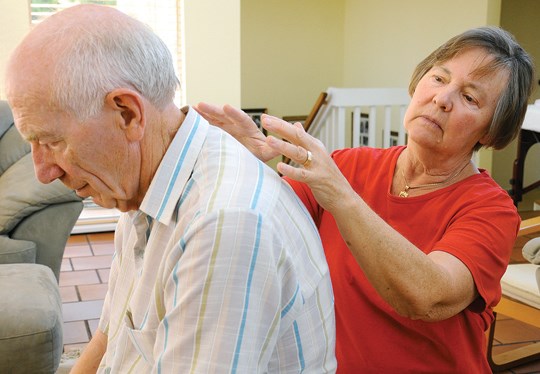Energy is universal.
At least that's the basis behind therapeutic touch and for Lynda Harvey, drawing from that energy can have many positive effects.
"It's an energy-based relaxation method that is practised all around the world," says Harvey,
a recognized therapeutic touch practitioner and teacher on the North Shore. "It mainly relaxes people because they have individual attention for a good 20 minutes and often just that relaxation response opens up the blood vessels."
She says it can help to create better circulation and reduce anxiety or tension.
Harvey, now a retired nurse, started therapeutic touch 30 years ago.
"I was at UBC taking my degree in nursing and I tend to be a perfectionist person and I was all keyed up about my assignments and exams," she says. "So somebody said, 'just go and sit down there for a minute and I'll do some therapeutic touch.' Within 20 minutes I was asleep upstairs and couldn't have cared less about assignments or exams or the world."
She says once she felt the benefits of it, she not only wanted to learn more and receive it regularly, but also wanted to share it with others.
"I sleep really well after I've had a session," says Harvey. "It has many benefits as do many other energy-based techniques."
Unlike chakra that has seven major centres, Harvey says therapeutic touch works on the body's energy collectively.
"We're bringing people back into wholeness in their body, their mind and their spirit," she says.
According to the B.C. Therapeutic Touch Network Society, the method was first introduced by Dolores Krieger and Dora Kunz in the 1970s and is a process of energy exchange where the practitioner moves their hands a few inches away from the body.
Harvey says most of the people she learned it with in the early '70s were nurses and they would take the therapy into hospital wards, cancer institutes and the community, as well as use it on palliative patients and people who were HIV positive.
"We don't do it as a business, there's a few people that do," she says. "My 30 years has all been volunteering except when I teach the class."
Teaching therapeutic touch involves three levels and each level is 12 hours that the instructor can fashion however they want. Harvey says she prefers teaching her sessions twice a week. The society sets the curriculum and the standards for teaching the therapy.
"It's sort of the governing body for when you want to call yourself a recognized therapeutic touch practitioner or a recognized therapeutic touch teacher," says Harvey. "You need to be receiving treatments on yourself regularly as well as offering them to, ideally, your family and friends first so you get your confidence up, and then offer it to the community whether they're well or ill."
Harvey says it can even help your pets and plants.
"All living things can benefit by this energy exchange," she says. "What you're learning to do is turn off your mind."
Harvey says the process is called centring, similar to meditation or prayer, and describes it as getting out of one's ego.
"You go into your heart centre and then you ask the universal energy to come from nature, the air, whatever, through you," says Harvey. "I'm just a conduit and then that energy moves through me, it makes me feel better and then it goes out back into the earth. So it's a whole different paradigm, whole different model of health."
Once a student has completed their levels, they receive a certificate of attendance.
"It's not a certificate of proficiency," Harvey says. "They're encouraged to come to the practice groups again to receive for themselves and to offer to others if they're really serious."
Students must get around 72 sessions, some of which are supervised and others where they receive therapy for themselves, and document each in their practitioner's workbook. As they document, they also evaluate.
"It's a very big process," says Harvey. "Then it gets sent to teachers who go through that person's journey from when they started offering sessions to when they become pretty proficient at it, and they judge according to criteria that's all set up if that person should receive their recognized therapeutic touch practitioner status."
Therapeutic touch sessions can vary in length, but Harvey says the rule is no more than 20 minutes.
"In that 20 minutes, our mind is totally focused on the other person and feeling their energy with our hands," says Harvey, adding that energy can also be felt through the various senses. "We all have different ways of picking up energy and balances."
She says in many instances, people cannot sit still or stay silent for longer than 20 minutes, so generally sessions do not exceed that.
Harvey is also involved in free therapeutic sessions on the North Shore as a practice group coordinator. The sessions are offered through Lions Gate Hospital, West Vancouver United Church and out of Harvey's own home.
"That's a community offering, anybody that hears about it can come and receive a free session with us and just watch what others do and be part of the centring meditation," she says. "Then at the end we get back together in our circle and people describe what
it felt like, if they have questions, they hear other people's stories."
Harvey says anybody can learn therapeutic touch.
"It's not that practitioners have a certain skill," she says. "Everybody can calm their mind and offer this peace, compassion to others."
Though there is skepticism about energy work, Harvey says once people experience it for themselves, the skepticism fades.
"You can't read about it or talk about it, you have to feel it for yourself," she says. "That's really important, to feel the value of it."
bctherapeutictouch.com



